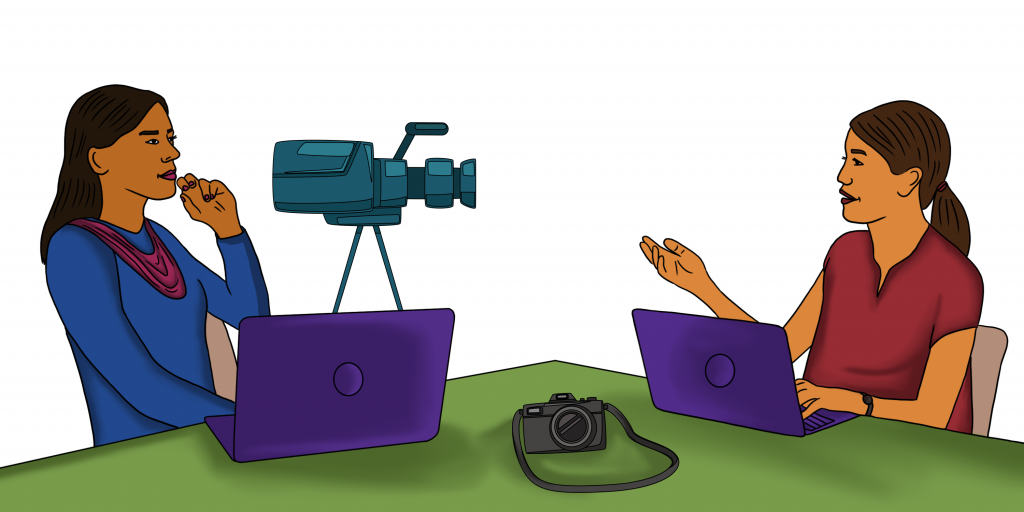By Annam Lodhi
“Ek Billi Moti Tazi see jo mazay say ding dong khati thi”
How many of you instantly recalled the iconic black and white cat with bells tied to its ears? Yes, it is the Ding Dong cat waking up from her sleep and chasing the mice!
How many of you remember the cartoons you watched on TV and the games you played? Does Mario ring a bell?
These are all animated items. A world that creates worlds and brings imagination to life.
In 2020, the global animation market was worth 270 billion U.S. dollars and is expected to surpass 300 billion by the end of 2021. According to the Minister for Information and Broadcasting Chaudhry Fawad Hussain, Pakistan can easily fetch a fair share of $ 8.4 billion from the gaming and animation industries.
However, historically Pakistan has rarely produced animated content except for a handful of examples. But things are changing. In 2018, four prominent animated films were released; Tick Tock, Allahyar and the Legend of Markhor, 3 Bahadur: Rise of Warriors and Donkey King.
Womxn too are more than ever interested in joining the field, not only because it is a versatile form of art but also because it allows them to express themselves like never before. We talk to womxn in the world of animation about their experiences and the future they predict.
KHAYA AHMED
Character Writer
While many might say they stumbled into animation, for Khaya it was an obvious choice, “My father was into animation too. But when we moved to Pakistan, he gradually grew away from it because it was not something people were interested in (in Pakistan) back then,” she shares.
She entered the world of animation at the mere age of 16, as a writer for the animated series ‘The Apartment Complex’ created by Numerical Studios. Her impressive portfolio contains badges as a consultant for Kamala Khan in Marvel Comic’s Eisner Nominated ‘Ms. Marvel’, writer and script coordinator for Emmy nominated and multi-award winner ‘Burka Avenger’ amongst others.
Recently she developed characters for the PlayStation 5 game, Destruction All-stars by the makers of Need for Speed: Payback. Two really interesting characters are named: Sgt Rescue and Twinkle Riot. They are of Pakistani and Middle Eastern origin. Sgt Rescue is a Canadian- Pakistani Pathan, a family guy who uses words like ‘Yaar’ and some Pashto slang during the game. While Twinkle Riot is from U.A.E.
Khaya has been into gaming since childhood and wanted to see characters with similar backgrounds in these games, when she was approached to develop characters she wanted to show them what Pakistan is all about and remove misconceptions.
Games usually lack ‘heros’ from this part of the world. “We see (characters from this area) in negative roles because of the various misconceptions we have abroad,” she shares, “It is important for us to also see ourselves as heroes instead of just terrorists in such games”.
Khaya understands her privileges, yet as a woman, she has had her fair share of struggles. Like having to deal with office politics, sexist and ageist remarks but Khaya has made sure she stands her ground. “I deal with unprofessional people by listening from one ear and letting it out the other, I compartmentalize, and I let my work do the talking. But if that doesn’t work, then I have a terse word with them because I’ve got the body of work to back me up,” she says.
She is currently working with FRAG Games on a new video game which will be a locally produced AAA scale game. Along with that she is also writing a Thriller game for Sugar Rush Studios and has numerous other projects in the bag.
As an independent writer, Khaya believes if she can do it many other womxn can too and encourages womxn to join this vast field, “The jobs they can pursue are: QA, animators (2D and 3D), artists and modellers/riggers (2D and 3D), writing, coding, post-production and video editing, Music production, graphic design, the list is endless”.
RASTI FAROOQ
Co-owner, Actor, Writer
Climbing the ladder in a male-dominated environment is the multi-talented Rasti Farooq. A graduate from LUMS who started as an intern in Shehri Pakistan, a civic and citizen literacy portal. The company’s aesthetic and the unique presentation of civic issues intrigued her, “Eventually we made animations on fundamental rights, democratic principles, what does it mean to be an active democratic person and we branched into value education,” she shares.
Ultimately, they started producing animated short stories and that is how PuffBall studio came into being. Within two years of graduating, Rasti now is not only the Co-owner at Puffball Studios but is also hopping roles. She is a key writer, producer, lead voice artist and director for different projects at Puffball. But she didn’t imagine getting such motivation early on in her career, “Because this isn’t how things normally work. Most animation studios have a very skewed gender ratio. I didn’t know the ins and outs of animation. I am a womxn and a whole bunch of other reasons to believe I won’t lead anytime soon.,” she says.
She also believes womxn aren’t encouraged to be part of the industry from their homes and once in the workforce studios give priority to male artists.
When she joined team Shehri Pakistan, she believed there would be seniority but it didn’t work in a hierarchical system and was particular about maintaining the gender ratio. She says it is not because they want to become a gender-neutral company but because they have experiences that female voices add to the space, makes the stories empathetic and they have experiences to share and add to storytelling, “Our creative landscape is saturated by characters, stories written by men and male gaze and perspective,” she says.
But to be a leader in a non-hierarchical space which is buzzing with young blood and ideas is not an easy feat. She claims one needs to be very imaginative about how they lead people in a non-traditional space. She had to curate the space for her fellows so that they could write and think freely about their most deep-rooted conflicts, propensities and insecurities. Of course, she would get anxious but had to deal with empathy and nuance, “It was hard because being a womxn I never expected myself to be in a leadership position handling so many personalities but it is rewarding”.
Having changed many hats, Rasti explains how she has been a co-writer, main actor, voiced multiple characters, and produced films because they do everything in house. From the conception of the story, writing, animation, storyboard, post-production and marketing, “We are a huge team and are broken between Rawalpindi and Lahore. And my job is to bring everyone’s creativity on a plain field,” she shares
For her, the writing experience has been incredible as it is usually improv, “Every time we write a character, it is immersing ourselves into the socio-political environment of the country so that it resonates with the people of the country,” she adds.
For Rasti this is just the beginning, she wants to pursue acting full time but this fall will be directing an upcoming animation film on the separation of Bangladesh, which she calls a “Surliest horror film”.
ISMA GUL HASSAN
Design Lecturer, 2D Animator
The Creative Director of Shehr-e-Tabassum – an animated Urdu short-film set in a dystopian future the first of its kind in Pakistan – thought that animation was not something she would be part of right off the bat. “As a design student in Pakistan, most of the offers we tend to receive are from advertising firms who are looking for graphic designers (or artists). Animation wasn’t big and still is in its infancy, especially 2D,” she shares.
Isma always wanted to do meaningful work and at Shehri Pakistan she was able to fulfil that goal by working on campaigns like the right to clean water, education, womxn’s rights, etc. Independently, she recently also designed the poster for the Aurat March 2021.
“I was interested in combining illustration with different fields but I didn’t think much about animation even though it was attainable,” she explains.
After she was hired she saw how her love for illustrations can be translated into 2D animations.
She believes the applications of illustration are ample and that design, in general, is moving towards social issues as it is a very effective medium, “It sums many words in a hard-hitting image and has an emotional element in it”.
Isma agrees that the world of animation is male-dominated, it is due to sexism womxn find it hard to pursue arts, “There is a general discouragement to let womxn pursue a career in arts. With art comes freedom which society is scared of to let womxn voice their views’ ‘.
She further adds that an overly male-dominated space would affect self-esteem and one’s creative soul. “Art requires time, space and a lot of creative freedom,” she says adding that womxn in the field “Need to have a greater sense of comradery, less competition, more community power and share opportunities and skills ”.
Irrespective of the prejudice in the industry Isma continues making art, “I survived by making my art regardless of what is happening around me. I wanted to put my art into the world, share it with people,” which she does online.
She encourages young womxn to join the industry because they bring a creative edge, “Womxn bring in their stories, personal experiences, stories we hear from others, everyone has a different lens. They bring sensitivity, nuance and specificity”.
She encourages womxn to join, “if they are passionate to tell stories…. Because they can be a director, actor, visual artist, anything they like because it is such a versatile area. You can explore your creative voice and apply it”.
She anticipates a boom in animation in Pakistan as people are becoming more and more tech-savvy and universities teaching the art. She also encourages interested people to learn as much as possible, not only formally but by observing their environment, communicating with society, because it is the everyday practice that enriches the art.
SADIA BASHIR
Founder Pixel Art Games Acacemy, Forbes 30 Under 30 Asia (2018)
With over ten years of experience in the gaming industry, Sadia is a role model for womxn. Coming from a humble background, Sadia was mesmerized when she first saw a computer at a friend’s place. She started playing games and earned an undergraduate degree in computer sciences to pursue the art of gaming. About five years ago, Sadia started her own gaming company and academy, The Pixel Arts Academy.
“I felt that there is a need for new people to join the industry but there weren’t many avenues to learn creating your video games,” says Sadia.
She restrains from adding animation and games in the same category. Claiming that the game industry in itself is bigger than the music industry and Hollywood itself. She explains that game development requires huge teams working together in various departments like; art and animation, quality assurance, production (producers and directors), sound design, game design, UX design, programming (vast field, AI, gameplay programmer, game engine programmer) writing story writing, scriptwriting, marketing, launch, publishing and much more. The industry is so vast that Sadia believes it can do wonders if developed properly in Pakistan.
“Gaming industry has potential but it is an untapped market (in Pakistan),” she shares, adding that the biggest opportunity for Pakistan to avail is to make authentic local stories that can capture international audiences, “If you add cultural aspects that makes your game very unique”.
She cites the example of the Indian game ‘Raji: An Ancient Epic”, the concept contained myths, the Hindu culture and has become a super hit being praised on various platforms internationally, “The reason for it becoming so epic is that it is a unique and original idea from their roots”.
The idea is not to be disappointed by failures. During her degree, Sadia along with her friends made numerous failed attempts at building games.
To this end, Sadia not only teaches beginner-level courses at her academy, finds mentors for students and also finds placements for them, “We wanted to build an academy where ppl can get started without prior experience in the field,” she shares.
The programme engages students to develop a game as part of their course. This not only helps them practise but builds their portfolio too, “They should learn how the industry works, how games can capture audiences and be good for them. How to excel in one of the biggest industries in the world”.
It is not shocking that the game industry globally is male-dominated and womxn are struggling to make their mark. Sadia’s journey is an intense one. Not only did she want to fit into the gaming industry, but she was also ambitious enough to aim for her enterprise.
“I didn’t see any similar examples around me and I was vigorously discouraged against my venture,” says Sadia.
The mentors and role models she looked up to were abroad who didn’t understand local context or the industry fully. When her work started gaining traction she was blamed for using the ‘womxn card’ by fellows, “It was difficult to get past the idea”.
Yet, those few voices didn’t harm her. The support of her family, friends, mentors and her determination kept her going.
Today when she visits universities she is met with queries from young girls who believe the industry isn’t for them, “For the benefit of young girls they need to see more female role models in the industry and at their universities,” she adds.
Sadia’s academy also provides fully and partially funded scholarships to female students attending her programmes. Womxn entering the field is crucial because they bring in diverse and unique perspectives with them, “When you have equal men and womxn ratio in a team the chances of the product being better and of greater quality is higher,” she explains adding that in her classrooms during brainstorming sessions the most unique and creative ideas come from womxn.
“It is not that womxn do not like playing games. But most games are centred towards the likeness of men,” she says emphasising why womxn should join and be part of the process of making games so that they can change the narrative of games, “They can make them more personal and likeable for womxn at large”.
But it is not a one-way street even though the number of womxn entering the field is increasing the office culture too needs to be improved, “Gaming companies should create a welcoming environment for womxn because I see a lot of hostility towards young womxn,” she says adding that mutual respect is needed in every team.

Future of Animation
In the past couple of years, Pakistan’s animation industry has sowed many seeds, studios like Mano Animation Studio, which is working on an anime style feature-length scheduled to release in 2022, Studio Rohkan, whose work spreads public service messages in the regional languages in a humorist way, SOC films one of the pioneers of animation in the country whose Burkha avenger was the first animated womxn superhero of Pakistan has been working on social messages on womxn rights under their series Siyani Sahelian.
Animation is picking up and appealing to the local audiences.
2D animation could be the future. Animations drawn on a 3D plane by hand which are not rendered through computer graphics nor CGI nor modelling and sculpting, according to Arafat Mazhar, an academic and Co-owner and director at Puffball.
For him, it contains a particular charisma, a personality and originality and lack of derivativeness which is difficult to achieve through 3D, “Every frame contains the voice of every artist. It looks unique because every frame is more deliberate. You arrive at a much richer world-building,” he says, sharing that both their films Shehr-e-Tabasum and Swipe required the new world to be built, which are very unique, and are South Asian because of their 2D work.
Even though universities too have started teaching animation courses, 2D animation is not focused on. “Our current curriculum is not robust enough for people who want to learn animation,” says Rasti
They do not have the right tools to provide to their students, nor the right instructors at large. Rasti believes the skills they learn in university are basic and the students interested in the art form need to perfect their skills through external courses and self-learning via YouTube.
The possibilities with animation are endless, it translates hard-hitting facts and ideas in a distilled form that are easily digestible and captivating for audiences of all ages.
Arafat sees potential in Pakistan entering the service industry, “Why can’t colouring be done in Pakistan?” he questions. “I advocate for training street artists and womxn who cannot work outside of the home, to learn how to colour and that itself is of great value in the animation industry”,
Yet at the same time, he argues that as the industry blossoms the stakeholders need to make sure that roles are not stereotyped and womxn are put in positions of labour only, “Womxn need to be clear in being given credit for their work before they begin work”.
Womxn can lead the way for animation, which is being used broadly in this piece. The avenues to explore and the spaces to fill are immense. Pakistan is already going places with its creations, already nominated and showcasing at various international platforms and festivals, working with and at international studios, the future is far from grim. All we need is a little help and a lot of motivation.






